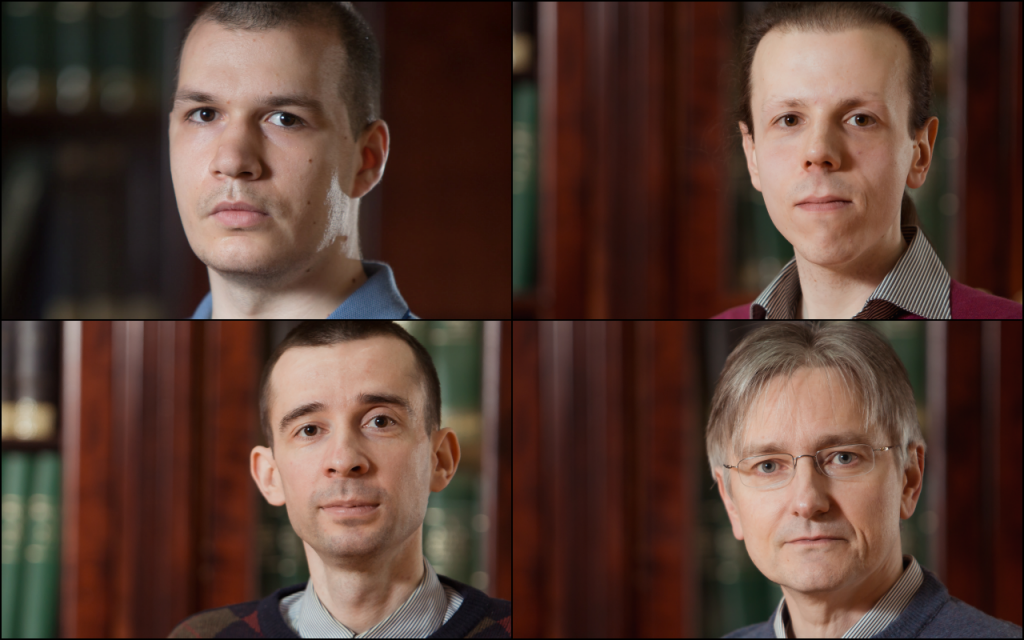
IPB researchers have achieved another internationally acclaimed feat, particularly among physicians who study electronic structures. A team consisting of Petar Mitrić, Dr Veljko Janković, Dr Nenad Vukmirović and Dr Darko Tanasković, has published a paper in the prestigious journal Physical Review Letters, which is considered one of the most influential in the world of physics.
In the paper titled Spectral Functions of the Holstein Polaron: Exact and Approximate Solutions, published in August 2022, our researchers demonstrated that the dynamical mean field theory, which is generally considered a good solution of the Holstein model but only in dimensions greater than two, offers an excellent approximate solution to the spectral function of this model in the whole range of parameters, no matter the number of the dimensions of the observed system.
To understand why this result is very significant, it is necessary to recall what the Holstein polarons are. Specifically, physicists use distinct concepts to successfully describe complex processes in crystal structures, one of the most vital ones being the so-called polaron, a quasi-particle which describes the interaction of electrons with ion vibration in a crystal lattice.
As stated, the concept of polaron was introduced in the 1930s, by the Soviet physicist Lev Landau and Solomon Pekar. They observed that the electron moving through a crystal is accompanied by a deformation of the crystal, which physicists came to know as a phonon cloud. To describe this, they introduced a quasiparticle which they named a polaron, which is a charge carrier in a semiconductor. The movement of polarons determines the amount of electricity in a certain material, thus determining the properties of all electronic devices.
The measurement of polaron mobility is one of the simplest measurements that physicists can conduct in an experiment. However, even though theoretical physicists managed to calculate various incredible things, it is still not possible theoretically, i.e. numerically, to determine the mobility of these quasiparticles.
To overcome and develop a general theory of polaron, physicists have tried to solve simplified models. One important example is the example of the Holstein polaron, named after American physicist Theodore Holstein, who studied the model in 1959, which describes a short-ranged interaction of electrons with Einstein’s phonons (crystal lattice vibrations).
‘This model has a major role in the understanding of transport process in real materials and the development of analytic and numerical methods in quantum physics of many-particle systems,’ explicates Dr Darko Tanasković, one of four authors of the paper.
The Institute’s researchers cite that the Holstein model can only be analytically solved within the confines of weak electron-phonon coupling and the so-called atomic limits. However, computer development in the previous decades has made it possible to learn a lot through numerical simulations. This is the reason why research focuses on the development of numerical methods which are to calculate precisely static and dynamic properties of the model over the broadest possible range of parameters. Nevertheless, a reliable solution for the spectral functions in the Holstein model was not feasible until the publication of the work of IPB researchers.
The team came up with an idea that the solution of this model in a broad range, may be granted by the dynamical mean field theory (DMFT). This convenient technique is usually used in situations when electrons cannot be observed in their free state and do not behave as an ideal gas. In the DMFT approach, using a small set of hypotheses, a complex model, whose dynamics is evident across the entire crystal lattice, is scaled down to a more simple problem of only one node of the crystal lattice, and the effective medium. ‘The main innovation in our work is the development of efficient analytical and numerical procedures, which allowed us to apply DMFT on low-dimensional lattices, providing us with quantitative predictions in one or two dimensions,’ states Dr Tanasković.
It is particularly interesting that the entire research team, who published this paper, originates from the IPB, having in mind that the paper employed several different and very complex numerical methods. According to the team, for this kind of paper, it is usually necessary to form a team from several different institutions for everyone to contribute their expertise in different numerical methods. ‘The work on the development of methods in previous years within our institution has opened doors for the entire research to be carried out here,’ Dr Tanasković believes.
The obtained DMFT solution can be applied in the future to systems of various dimensions, and it is useful when determining the range of other methods’ applicability, which is to ensure a precise calculation of charge carriers’ mobility. It can have applications in the development of optimal semiconductors for solar-cell purposes, LEDs and thermoelectric devices, the authors of this paper claim.
To obtain the result that the Institute’s research team managed to get, it was necessary to wait for the right moment. Several methods to calculate the interaction of many-particle quantum systems were fundamental here. ‘It is difficult to imagine having been able to reach this solution a decade or more ago. The development of ideas and algorithms in recent years has simplified precise calculations for such complex systems,’ says Dr Tanasković, concluding that this was crucial to confirm the hypothesis about the satisfactory accuracy of the obtained DMFT solutions.
*
Text: Jovana Nikolić and Slobodan Bubnjević/ IPB Communications
Spectral Functions of the Holstein Polaron: Exact and Approximate Solutions




